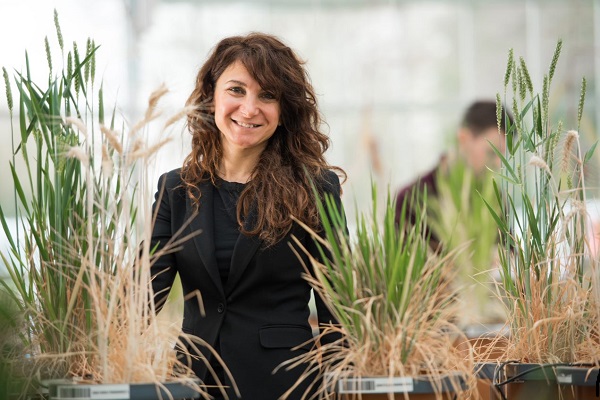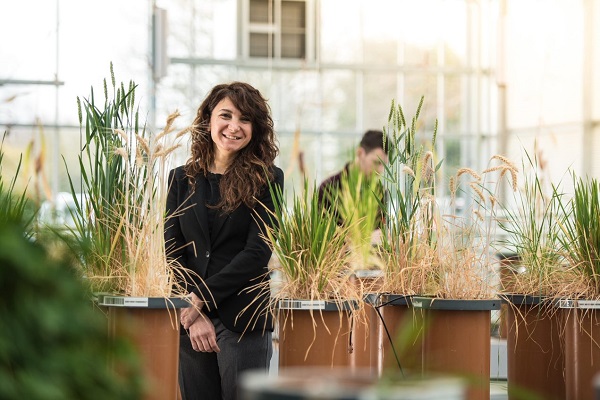
June 12, 2019, by Jo Gregory
Dottorini does data: introducing our Green Chemicals research team
Tania Dottorini is an Assistant Professor in Bioinformatics and an Associate Director for the Green Chemicals Beacon. Tania leads a team of scientists working across computational science, machine learning, bioinformatics and systems biology, and leads the computational chemistry research programme for the Green Chemicals Beacon.
In this interview, Tania talks to Jo Gregory about her research, her inspirations and her collaboration with the Green Chemicals Beacon.
Tell me about your role here?
My research and interests revolve around studying and answering biological questions related to human and animal health which involves using and integrating machine learning and bioinformatics. I work with large sets of data to correlate genomic information from pathogens and also other types of variables, for example the environment, the type of host so whether it’s human or animal, and try to understand how pathogens infect the different hosts and how this can be prevented.
How did you become involved in this kind of work?
I come from a different background as I was previously working at Imperial College where my research was focused on malaria. I was attracted to Nottingham by the opportunity to research bacteria, superbugs and antimicrobial resistance and I’m really excited by the work I am doing. I love to spend hours brainstorming a way to find answers to biological questions, for me that’s the most exciting thing about science.
How do you describe what you do to an ordinary person?
I’m really interested in antimicrobial resistance, how bugs become superbugs and how they acquire this capacity to completely destroy the power of medicines and drugs.
How does being based within the Green Chemicals Beacon help you achieve your goals for the future?
The Green Chemicals Beacon has given me a great opportunity because my aim is to create a computational core whose research objectives are in line with the goals of the Beacon. We will soon have five senior people working in machine learning, bioinformatics and systems biology, and they will be altogether in the same room, sharing information and ideas, which I believe is a unique and essential environment. My aim is to reach out to as many colleagues as possible both within the University and beyond so that we can collaborate to make great science.

How does your research affect ordinary people?
I hope I will be able to help people in need. Lately, I have focused my research on health related challenges in developing countries. I think knowledge is the most important thing. Knowing how things are changing, and knowing what is going on, in particular on antimicrobial resistance, is of fundamental importance for our society. Antimicrobial resistance is one of the most important challenges as it poses an increasingly worrying threat worldwide. I have learnt that anything can happen at any moment especially when you least expect it, so when you talk to people and you spread and receive knowledge just by communication that’s the moment where you can build things up. My goal now is to let people know what we can do in terms of computational science, data analytics, bioinformatics and disease. Machine learning is a cutting-edge approach to tackling antimicrobial resistance, and as well as understanding this approach I want to spread the message and attract people with innovative ideas so that we can share and evolve. Collaboration is the secret to doing this, and I am very open to collaborating and sharing.
How will your research help the beacon achieve their goals of securing the sustainable bio-economy of the future?
I will lead on the development and application of bioinformatics strategies, integrated solutions and automated workflows, to inform metabolic engineering strategies, enabling the optimisation of microbial cell factories. Using the advanced computational tools we have developed will play a vital role in assessing the feasibility of alterations in host organisms including bacteria, cyanobacteria and yeast host systems. My team will also augment existing systems’ biology methodologies with these computational tools to expand the capability to redistribute carbon flux to desired products
What does a typical day look like?
I try to reserve a part of my day to do some science as I love to do data analysis. I’m also addicted to designing research projects around interesting new ideas! It is difficult but very enjoyable as you have to brainstorm a lot around a theme and for me this is when research happens. I also meet with my students which I really enjoy and is another opportunity to think about science. I like to collaborate, both with colleagues within the University and outside because I think it’s very important to share ideas. My research team is working on lots of different biological questions, so together with antimicrobial resistance, which is my primary focus, I work on many other projects. What I learn from one project can be used in another.
The big change from what I was doing in the past and what I am doing now is that I have a calendar, and lots more meetings, but the essential elements of my day are trying to reserve time for my research, for writing grants and for collaboration.

Where do you get your inspirations from?
My father was a scientist so it started from him. I loved hearing his discussions about his research and the papers he was writing. I also really loved my university studies. I read so many inspiring books as I was studying both in Australia and in Italy. Also, reading about incredible women that made the history of science really motivates me, many of whom were not recognised and doing science in a very hard period for women to do science. Rosalind Franklin in particular I find truly inspiring.
The UK also really stimulates me. After my degree I got a fellowship to work with Daniela Rhodes at MRC at Cambridge. I spent a year in her lab doing crystallography. It was like being in a Harry Potter book, the old colleges, eating dinner with professors, the tradition fascinated me so much. The lab I worked in with the crystals was in a basement, the temperature was four degrees, and it was a scary place, but it was also really inspiring, and made me realise that the UK is where I wanted to do my research. As a young scientist that is really special. I have been so lucky to have such inspiring scientific moments in my life that have irreversibly touched me.
Do you have any advice for young scientists?
Always believe. If you really love science never give up. It’s very difficult but keep going because if you are really, deeply in love with science sooner or later you will get what you want! The secret is to be driven, to follow your desire but you have to really believe and feel that you want that. I knew I wanted to be a scientist when I was very little. I always loved science and the discovery. You can have very good moments and also very bad moments which can last for a long time, but never give up. If you believe in something just keep going with that. Trust your feelings and trust yourself
What is your greatest career moment so far?
I think now. I am extremely happy about the possibility of doing great science with my antimicrobial resistance projects and I am strongly optimistic about the outcome of the work I’m doing with the Green Chemicals Beacon. I believe in my collaborators, in particular my colleague Professor Richard Emes, with whom I share a lot research, students and the office! I’m also building a new team with lots of new scientists about to join my research team which is really exciting and a great moment.
Tania is currently recruiting for a number of roles in her team. You can find details of all opportunities on the Green Chemicals Beacon website.
No comments yet, fill out a comment to be the first

Leave a Reply